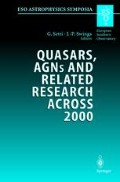Abstract.
Very long baseline interferometer measurements provide direct evidence for highly collimated relativistic motion in quasars and AGN with apparent velocity typically around 3c, but extending up to about 20c. In general, radio galaxy jets appear to move with slower speed than quasar jets, while jets associated with quasars that show strong gamma-ray emission appear to move the fastest. Surprisingly, there appears to be little or no evidence for Doppler boosting at the level corresponding to the observed superluminal motion. It is difficult to explain the high brightness temperatures deduced from observations of intra-day-variability in terms of Doppler boosting. Coherent emission mechanisms may need to be considered.
Preview
Unable to display preview. Download preview PDF.
Author information
Authors and Affiliations
Editor information
Rights and permissions
About this paper
Cite this paper
Kellermann, K.I. Relativistic Outflow in Quasars and AGN. In: Setti, G., Swings, JP. (eds) Quasars, AGNs and Related Research Across 2000. ESO ASTROPHYSICS SYMPOSIA. Springer, Berlin, Heidelberg. https://doi.org/10.1007/10719740_3
Download citation
DOI: https://doi.org/10.1007/10719740_3
Published:
Publisher Name: Springer, Berlin, Heidelberg
Print ISBN: 978-3-540-42191-7
Online ISBN: 978-3-540-45326-0
eBook Packages: Springer Book Archive

